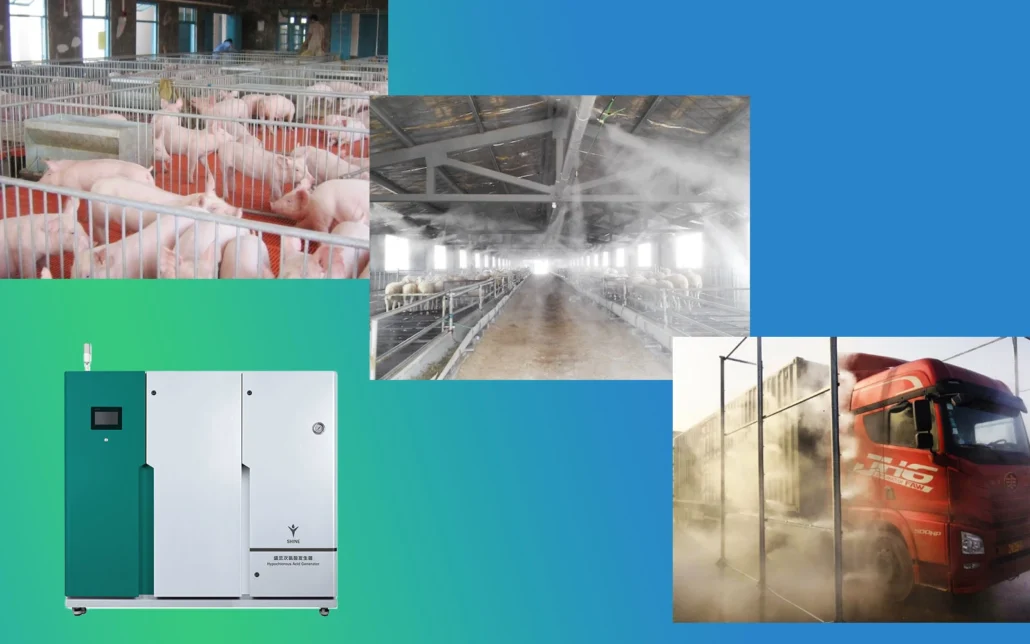Disinfection Methods: Reducing Costs and Boosting Efficiency
Before and after the outbreak of African swine fever, the mindset of farmers has undergone a revolutionary change. In the early days, farmers lacked the motivation to enforce disinfection strictly. As they said, “I might spray a couple of times when in a good mood, but I would forget when busy.” Some pig farms didn’t have the professional ability to accurately calculate the amount of disinfectant needed for a certain area. Others judged based on their senses, believing that the stronger the irritation, the better the disinfection effect. To prevent and control African swine fever in pig farms, not only is disinfection necessary, but also the selection of effective disinfectants is crucial. The cost of disinfectants should not be simply calculated by the price alone, but rather by considering the input-output ratio.
The extensive use of disinfectants by farmers has also led to an increase in pig farming costs. “In the past, for routine disinfection, two RMB per pig was sufficient. But now, the cost has multiplied by 5 to 10 times or even dozens of times.” Take the commonly used potassium peroxymonosulfate disinfectant in pig farms as an example. A 5KG disinfectant costs 120 RMB, and the dilution ratio is 1:200. The price per liter of this disinfectant is 0.12 RMB.
For the SHINE diaphragm-less electrolytic hypochlorous acid equipment (with dilute hydrochloric acid as the electrolyte), considering equipment depreciation, water and electricity expenses, and electrolyte consumption, the cost of producing 1L of hypochlorous acid water with an effective chlorine concentration of 100ppm is only 0.06 RMB, which is half the cost of potassium peroxymonosulfate disinfectant.

Multiple Functions in One Machine: Full Coverage in All Scenarios
Hypochlorous acid water has wide applications in farms, including disinfection and deodorization of the breeding environment, personnel disinfection, shed disinfection, drinking water disinfection, office environment disinfection, and disinfection of fresh food entering the farm. It has high safety, causes no corrosion to equipment, and has no irritation to breeding animals and personnel, thus having excellent application prospects in the breeding field!
1.The Demand for Disinfection and Sterilization in Modern Breeding Enterprises
Modern pig farms adopt highly intensive production methods. However, if measures such as management, environmental hygiene, and disinfection are not implemented properly, it can result in a harsh breeding environment and lead to diseases. Hypochlorous acid, as a new type of disinfectant, can effectively and safely purify and disinfect the breeding environment and has been widely used in pig farms. It can be used for disinfection and deodorization in livestock and poultry houses, vehicle disinfection, personnel disinfection, and disinfection of drinking water pipelines, showing broad prospects.
(1) Disinfection and Deodorization in Livestock and Poultry Houses
Ammonia gas (NH3) is one of the main harmful gases in livestock and poultry houses, especially in pig houses. It can cause conjunctivitis in livestock and inflammation of the upper respiratory tract. Long-term exposure can even induce chronic ammonia poisoning, leading to a reduction in the body’s resistance, making animals more prone to diseases and affecting their growth.
Spray treatment with hypochlorous acid water can effectively reduce the total number of colonies in the air of pig houses. The reduction effect is significantly better than that of the control group, with a decrease rate reaching 71.24%. After spraying for 3.5 hours, the total number of colonies in the air of the pig house is lower than the initial amount.
Empty House Disinfection:
After high-pressure flushing the empty house with tap water, use slightly acidic electrolyzed water with an effective chlorine concentration of not less than 150 mg/L for whole-house spray disinfection.
Production House Disinfection:
Regularly conduct spray disinfection with livestock and poultry present. For broilers, it is advisable to do it twice a day; for laying hens, once a day; and for pigs, cattle, and sheep, twice a day. The frequency should be appropriately increased in summer according to the situation. In winter, when the outside temperature is low, it can be sprayed after heating. Disinfection is best carried out at noon. Spray disinfection should be conducted using slightly acidic electrolyzed water with an effective chlorine concentration of 100 mg/L to 150 mg/L. The spray volume should be 30 mL/m2 to 50 mL/m, and the particle size of the mist should be 50μm to 120μm. When spraying, try to avoid spraying onto the feed trough and the surface of eggs.
Farm Area Environment Disinfection:
The roads in the farm area and the environment around the livestock and poultry houses should be frequently swept to keep the farm area clean and hygienic. Use slightly acidic electrolyzed water with an effective chlorine concentration of not less than 150 mg/L for spray disinfection at least once a week.
Drainage Ditch and Sewer Outlet Cleaning:
The drainage ditch and the sewer outlet should be regularly cleaned and flushed with high pressure using slightly acidic electrolyzed water with an effective chlorine concentration of not less than 150 mg/L, once or twice a week.
Office and Living Area Disinfection:
Use slightly acidic electrolyzed water with an effective chlorine concentration of 100 mg/L to 150 mg/L to spray disinfect the space and ground of the office area and living area. The spray volume should not be less than 150 mL/m².
The application research of hypochlorous acid water in the breeding industry is a new way to open up disease prevention and efficient and healthy breeding of livestock and poultry from a new perspective. Its characteristics of efficient deodorization and sterilization, no residue, no pollution, easy operation and low price determine that it has very significant social and economic benefits and broad application prospects in pig farms.
